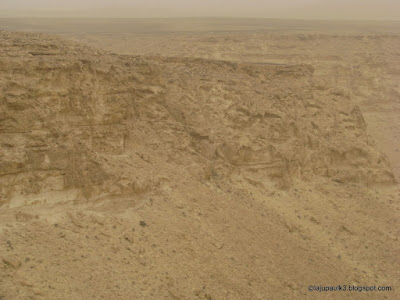"16 And it came to pass on the third day in the morning, that there were thunders and lightnings, and a thick cloud upon the mount, and the voice of the trumpet exceeding loud; so that all the people that was in the camp trembled. 17 And Moses brought forth the people out of the camp to meet with God; and they stood at the nether part of the mount. 18 And mount Sinai was altogether on a smoke, because the LORD descended upon it in fire: and the smoke thereof ascended as the smoke of a furnace, and the whole mount quaked greatly. 19 And when the voice of the trumpet sounded long, and waxed louder and louder, Moses spake, and God answered him by a voice. 20 And the LORD came down upon mount Sinai, on the top of the mount: and the LORD called Moses up to the top of the mount; and Moses went up" (Exodus 19:16-20).
Since generations Mount Sinai, where God gave 'Ten Commandments' to Moses has been an eagerly sought-after site. Counting from Mount Serbal (since 4th Cent. AD) and the most popular Mount Katherine (traditional site since 6th Cent. AD), more than a dozen candidates are assigned, which are widely distributed in Egypt, Israel, Jordan, Saudi Arabia and even Yemen. Every site has its own justifications for being considered and yet has serious flaws that can challenge its validity. In the case of Mount Karkom, it all began when an young Italian Archaelogist named Emmanuel Anati first arrived the region in 1954. Based on subsequent expeditions and detailed archaeological surveys conducted on an area of 200 sq.km in and around Har Karkom, Anati proposed in 1983 that the mountain may be identified with the holy mountain referred to by biblical narrations as Mount Sinai. Rising at an altitude of 847 meters above mean sea level, Mountain Karkom (Mount of Saffron in Hebrew) is also called Jabal Ideid (Mount of Celebrations in Arabic).
What is so special about Mount karkom?
Mount Karkom and its surroundings are abundant with 1,200 archaeological sites; 218 rock art sites with 1300 rocks engraved by more than 40,000 petroglyphs (rock engravings); Palaeolithic (pre-historic era) remains spread over 239 sites with hut basements, 42 fireplaces, and 55 flint workshops; 25 sites of geoglyphs (a large drawing on ground); 60 orthostats (standing stones)-all made of local stone spanning 40,000 years!
Among the rock engravings, many biblical symbols such as the table with ten partitions (which was defined representing “The Ten Commandments”), the figure of the “serpent and the staff” (the rod of Moses that turned into a serpent before Pharaoh), “the eye of God that looks from the rock” and the menorah (Jewish candlestick) are well known already. In addition, 12 standing stones resembling the ones erected by Moses, large flint workshops (remind you flints were used for circumcision by Israelites in the desert) and a large natural open area at the base of the mountain where thousands of people can gather (The Israelites under Moses are estimated 3 million) are identified. Nothing similar has been found in other mountains in the peninsula or in other rock art sites. Based on these evidences and much more Anati proposes Mount Karkom as Mount Sinai.
Why Mount Karkom cannot be Mount Sinai?
Like every proposed Mount Sinai candidate, Mount Karkom has also its loopholes. The biggest hindrance is the mismatch arising while dating the mount with exodus. Based on C14 dating and other analysis, Anati and his team identified Mount Karkom being occupied from Paleolithic to Chaloclithic (40,000 to 3400 BC); Early to Middle Bronze Age (3400-2000 BC) and later Roman, Byzantine and Islamic Periods. Between 3,300 and 2,000 BC was the period of the most intense occupation. However, reasons unknown the region was found abandoned from 2000 BC to 900 BC. The Biblical Exodus of Israelites from Egypt is usually dated between 1600-1200 BC and since there is no evidence of any human occupation at Har Karkom during that period, Anati pre-pone the event to a much earlier period, i.e. in the third millenium BC!
Why visiting Mount Karkom was special to me?
You can't reach Mount Karkom by public transport or taxi or even by private vehicle. Not because it is inaccessible, but it is restricted. Located a few kilometers from the Egypt-Israel border, Mount Karkom is in a closed military zone. Hence you need special permission from the Israeli military to reach the spot and civilians are allowed only on Fridays and Saturdays. Once you are allowed to travel through the narrow military road, you need to find special safari trucks to travel the final 45-60 min bumpy ride through a very nasty dirt road to the base of Mount Karkom. Thats not all, you should be always accompanied by person(s) with licensed gun(s). Fulfilling all these conditions were not an easy task. But luckily, I managed to find a slot with a pre-planned tour group who got special permission for the vist. A big thanks to Yigal our tour guide-cum-organiser and Gila for booking my seat months before the trip was organised. Thanks again to both of you.










































